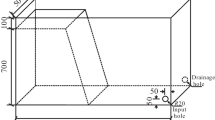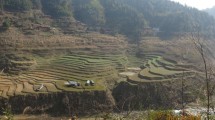Abstract
Reservoir bank collapse is a type of hydrogeological phenomena encountered in hydropower projects, and its prediction remains a challenge. The reservoir bank collapse width in the loess area of China is predicted based on the empirical graphical method established by scholars from the Soviet Union; however, the prediction results are quite different from the actual value. In this study, a field investigation was conducted on the bank slope topography after reservoir bank collapse in a loess area. The results showed that the water bank slope remained vertical after the bank collapse, and the accumulation form of the underwater bank slope followed an exponential curve. When the ratio of the water depth to the bank slope height after bank collapse was less than 0.3, there was an accumulation bank slope above the water. When this ratio was greater than 0.3, the accumulation slope was underwater. Based on the water depth and bank slope height after bank collapse, a formula to predict the topography of the underwater accumulation slope was established. Combined with the characteristics of the post-collapse bank slope, a prediction method for loess bank slope collapse was established. The topography of the bank slope predicted by this method was consistent with the field investigation results. The physical and mechanical properties of the bank slope loess and the characteristics of the bank slope were considered, thus overcoming the shortcomings of the conventional graphical method based on empirical parameters. This study has practical significance for prediction of loess bank collapse.

















Similar content being viewed by others
Data availability
The data used to support the findings of this study are available from the corresponding author upon request.
References
Andrew S, Andrea C, Stephen ED, Langendoen JE (2000) Bank and near-bank processes in an incised channel. Geomorphology 35(3–4):193–217. https://doi.org/10.1016/S0169-555X(00)00036-2
Andrew S, Darby ES (1997) Process-form interactions in unstable sand-bed river channels: a numerical modeling approach. Geomorphology 21(2):85–106. https://doi.org/10.1016/S0169-555X(97)00043-3
Bao G, Li H, Zhang Y, Zhang W, Jiang N (2018) Experimental study on shear strength of unsaturated loess based on different water content in Xining Area. IOP Conference Series: Earth and Environmental Science
Couper PR, Maddock IP (2010) Subaerial river bank erosion processes and their interaction with other bank erosion mechanisms on the River Arrow, Warwickshire. UK Earth Surface Processes & Landforms 26(6):631–646. https://doi.org/10.1002/esp.212
Dapporto S, Rinaldi M, Casaglic N (2001) Failure mechanisms and pore water pressure conditions: analysis of a riverbank along the Arno River (Central Italy). Eng Geol 61(4):221–242. https://doi.org/10.1016/S0013-7952(01)00026-6
Gu T, Liang Y, Hu W, Zhu L, Wang X (2017) Experimental research on disintegration of the Heifangtai loess. Hydrogeol Eng Geol 44(04):62–70. https://doi.org/10.16030/j.cnki.issn.1000-3665.2017.04.10
Hu X, Lu B, Hou Z (2022) Bank slope types and bank collapse prediction of new Checun reservoir. Sci Technol Eng 22(15):6301–6307
Hu Z, Shao S, Chen C (1996) Research and analysis on collapse of loess reservoir bank. West-China Exploration Engineering (S1)
Ji F, Liu C, Zhou H, Liu H, Liao Y (2018) Identifying the influences of geological factors on reservoir bank collapse by a model test. Bull Eng Geol Env 77(1):127–139. https://doi.org/10.1007/s10064-016-0951-x
Jia H, Ma S, Wang Z, Shi H, Gong L (2005) Prediction of rock reservoir bank reconstruction at the new site of Wushan County in the Three Gorges Reservoir Area. Bull Geol Sci Technol (S1):189–191+195
Jiang G, He J (2009) Study on prediction method of reservoir bank collapse in Wuding River basin. Yellow River 31(03):68–69
Jiang Z, Wang Q, Zhang Y (2008) Bank collapse mode and long term bank collapse width prediction of Wanggedu Reservoir. Yellow River (03):78–79
Kachugin EG (1949) The reworking of banks in cases of river affluence. USSR Academy of Sciences Publishers
Kondratjev NE (1956) Forecast dealing with bank reshaping in the area of water reservoir under the effect of wave action. Hydrometre Publishers
Li C, Ma X, Gao D, Li Z, Li P, Li T (2022) Model test on bank collapse of Weibei Loess Plateau Reservoir under different water levels. Yellow River
Li XA, Wang L, Yan Y, Bo H, Li L (2019) Experimental study on the disintegration of loess in the Loess Plateau of China. Bull Eng Geol Environ 78(7). https://doi.org/10.1007/s10064-018-01434-6
Li Y (2014) Study on control of soil slope landslide in loess gully region reservoir. J Taiyuan Univ Technol 45(06):833–836. https://doi.org/10.16355/j.cnki.issn1007-9432tyut.2014.06.015
Liang Y, Gu T, Hu W, Zhu L, Wang X (2017) Experimental study on disintegration of loess in different regions. Science Technology and Engineering 17(20):93–100
Liao Y (2016) Study on prediction of soil bank collapse of reservoirs in mountainous areas Chengdu University of Technology. Sichuan
Ma S, Jia H, Tang M (2002) Analogy method with stable side shape to predict reservoir side rebuilding of rock shore. Earth Science (02):231–234
Peng S (2014) State-of-art art of bank collapse predicting of reservoir and a balanced alluvial accumulation approach. Chinese J Rock Mech Eng (11):2332–2340. https://doi.org/10.13722/j.cnki.jrme.2014.11.017
Pu S (1983) Deformation of reservoir bank slope in loess area. Yellow River 05
Song Y, Duan S, Chen S (2004) Analysis on influencing factors of bank collapse in Guanting reservoir. Design Water Resour Hydroelect Eng (01):34–37
Sun G (1958) Study on reservoir bank collapse. Water Resources and Hydropower Press
Wang Y, Tang J, Ling J (2000) Study on prediction method for reservoir bank caving. Chinese J Geotech Eng (05):569–571
Xu Q, Liu T, Tang M, Huang R (2007) A new method of reservoir bankcollapse prediction in the Three Gorges Reservoir—river bank structure method. Hydrogeol Eng Geol (3):110–115
Yuan L (2017) The experimental study on disintegration of loess Northwest University. Xi'an
Zhang DH, Inoue N, Hamanaka A, Sasaoka T, Sasaoka T, Matsui K (2015) Stability effect of water content on dominant loess dumping areas. International Symposium on Land Reclamation and Ecological Restoration, LRER 2014 - Beijing, China
Zhang W, Wang W, Gao X (2019) Influences of reservoirs water level drawdown on slope stability. Eng J Wuhan Univ 52(01):21–26. https://doi.org/10.14188/j.1671-8844.2019-01-004
Zhang Y, Qu Y, Wang H, Ren S, Li Z (2022) Bank stability analysis and collapse prediction for loess reservoir after impoundment in Northern Shaanxi. Northwest Hydropower (01):42–46+52
Funding
This work was supported by the National Natural Science Foundation of China (41877242), the Fundamental Research Funds for the Central Universities, CHD (300102260204, 300102261507, 300102281202), and the Scientific research project of POWERCHINA Northwest Survey, Design and Research Institute Co., Ltd (XBY-KJ-2019–19).
Author information
Authors and Affiliations
Corresponding author
Ethics declarations
Conflict of interest
The authors declare no competing interests.
Rights and permissions
Springer Nature or its licensor (e.g. a society or other partner) holds exclusive rights to this article under a publishing agreement with the author(s) or other rightsholder(s); author self-archiving of the accepted manuscript version of this article is solely governed by the terms of such publishing agreement and applicable law.
About this article
Cite this article
Ma, X., Li, T., Gao, D. et al. Study on prediction method of reservoir bank collapse in loess area. Bull Eng Geol Environ 82, 335 (2023). https://doi.org/10.1007/s10064-023-03368-0
Received:
Accepted:
Published:
DOI: https://doi.org/10.1007/s10064-023-03368-0




